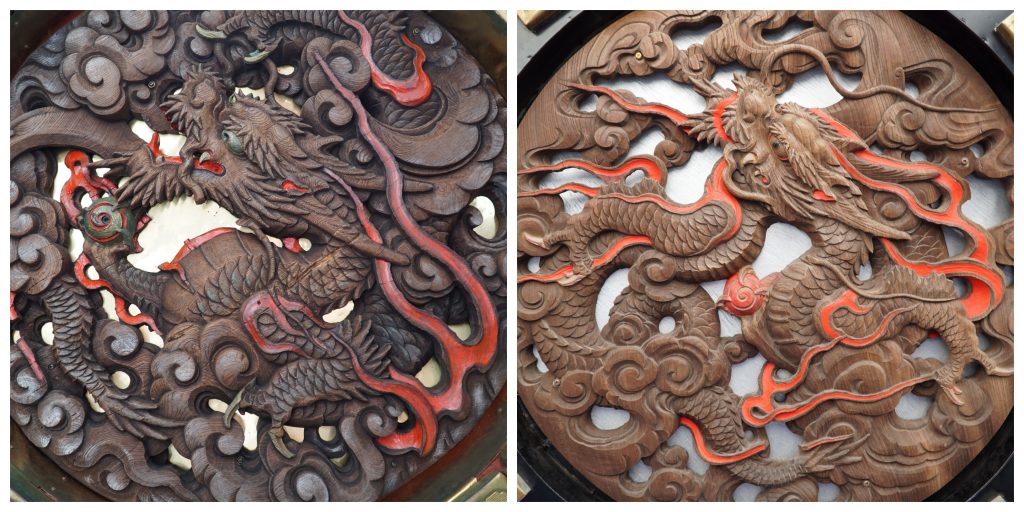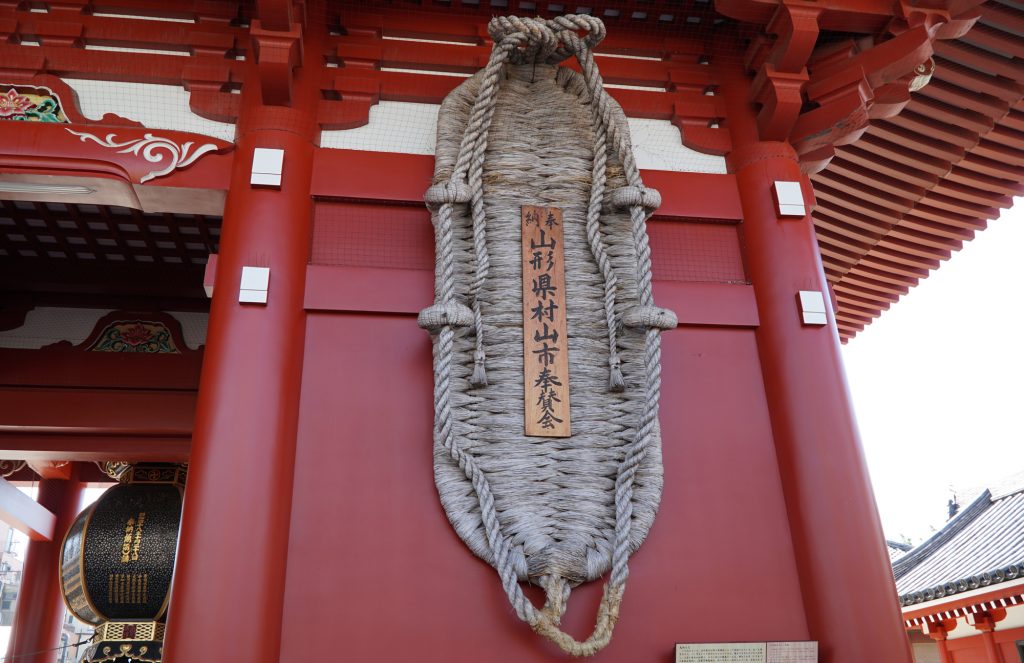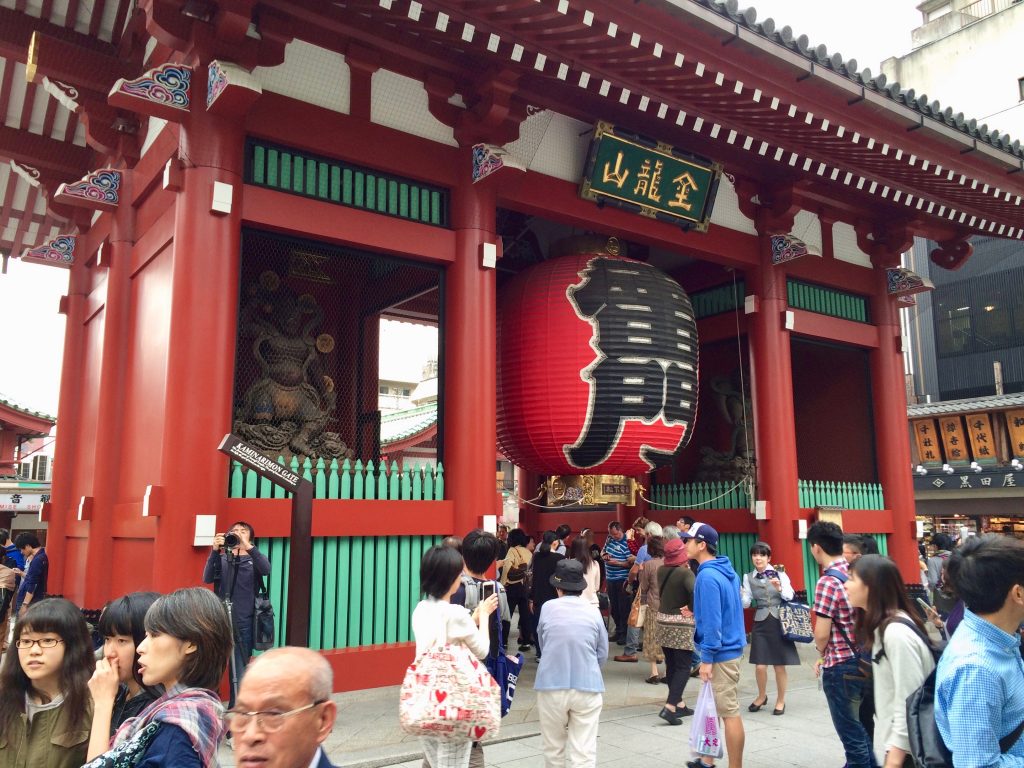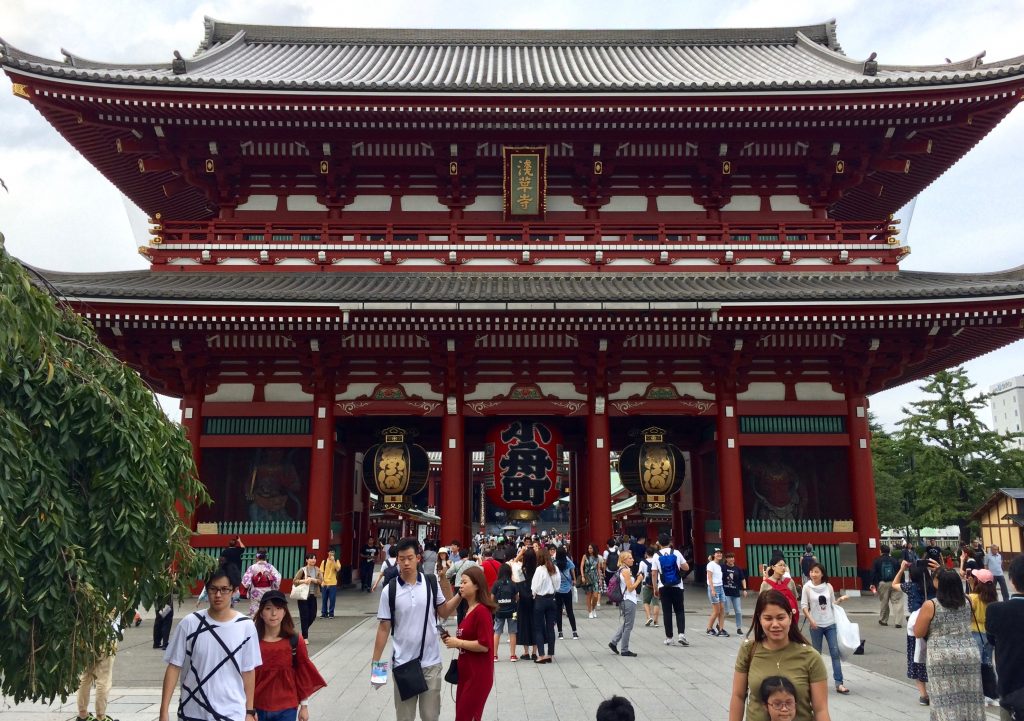Senso-ji (Sensō-ji), widely known as Asakusa Kannon Temple, is Tokyo’s oldest buddhist temple. Located in Asakusa, one of Tokyo’s most lively and busy districts, Senso-ji is one of the most visited spiritual sites in the world. This bright and colorful temple attracts so many people from all over the world that at times it’s even hard to walk around the temple grounds. In this post I present a bunch of interesting stories and details about the temple. If you want to make your visit at Senso-ji extra good and get even more insight in rituals and history then you can book a guided tour of Senso-ji here.
The History of Senso-ji
Senso-ji was founded almost one and half millennia ago, in 645. The legend says that in 628 two fishermen caught a statue of Kannon, the goddess of compassion, in the nearby Sumida River. They tried to get rid of it, but it kept coming back to them. Taking it as a sign, the head of the fishermen’s village erected Senso-ji in honor of Kannon. The temple holds the original Kannon statue, however it can never be seen by the public and is supposedly stored safely inside 3 boxes.

At the time when the Senso-ji was founded the area was merely a village and the temple a converted house. What we know as Tokyo today didn’t even exist – Senso-ji outdates Tokyo! With the founding of the temple eventually came a transition from village to town. The temple evolved over the years. Parts were built, destroyed or changed.
With the coming of the Tokugawa shogunate in the 1600’s Tokugawa Leyasu made Senso-ji the family temple of the Tokugawa clan. During the Tokugawa period Edo (today Tokyo) grew from a smaller fortification to the biggest city in Japan in a very short time, eventually swallowing up the town of Asakusa. Naturally Senso-ji has been the heart of Asakusa for hundreds of years, and even today Senso-ji defines the Asakusa district.
Tokugawa Shogunate, a feudal military government existing from 1600 – 1868. The head of a shogunate is the “shogun”. During this period the Shogun was always a member of the Tokugawa Clan – hence the name.
In 1868 the Tokugawa Shogunate fell, and Japan entered the Meiji restoration period. In the process of modernizing and westernizing Japan, the two main religions, Buddhism and Shinto, were separated and Shinto was made the main religion of Japan. That meant a goodbye to Buddism, and the significance of Senso-ji quickly fell to none. Funding to the temple was removed, and the temple area was designated a park and named Asakusa park. The area turned into an entertainment district, but the main hall of the temple remained intact.
Meiji Restoration Period, a period following the fall of the Tokugawa Shogunate. Emperor Meiji regained control of the country, and Japan was heavily modernized.
The temple buildings were destroyed during world war 2, but they were reconstructed shortly after the war. The reconstruction of Senso-ji became a symbol of Japans restoration after the war and the temple regained it’s place as the heart of Asakusa.
Visiting Senso-ji
Kaminarimon Gate – first gate
The first of two gates leading to Senso-ji is Kaminarimon Gate, also known as “Thunder Gate”. The gate was first constructed in 941, and was originally located south of it’s current location in the Komagata area. In 1635 the gate was reconstructed closer to the temple where it can be seen today. The gate seen today is not the original one though – it has suffered under many fires over the years. The original gate burned a few years after it’s installation and was only rebuilt by a Tokugawa Shogun in 1649. In the 1700’s and 1800’s the gate burned to the ground a few times. The gate you see today was built in 1960.
Statues
The Kaminarimon Gate is a popular photo spot with visitors, probably due to it’s size and slightly intimidating protectors. In each side of the gate are placed large protective statues. On the right side Fujin – the god of wind. On the left side Raijin – the god of lightning, thunder and storms. The statues haven’t been around since the beginning – they are thought to have been added to the structure when it was relocated in the 1600’s. They have also suffered under the fires, and the current statues are from 1960, like the gate itself.
On the other side of the gate two smaller statues are installed. These statues depict the Buddhist god Tenryu and the goddess Kinryu. Their names mean Heavenly Dragon and Golden Dragon respectively. Dragons have been closely tied to Chinese and Japanese Buddhism for many years, and they have become symbols of the religion. Dragons not only function as protectors, but are considered symbols of the enlightenment which is so central in Buddhism. That’s why dragons are often depicted holding a mani jewel, the symbol of Buddhas teachings.
Actually, Senso-ji’s correct name is “Kinryū-zan Sensō-ji“, Kinryu-zan meaning “The mountain of the golden Dragon“.
Lantern

In the middle of the Kaminarimon Gate hangs a 4 meter (13 ft) tall traditional lantern called a chochin. On the front of the lantern is written “Kaminarimon”, on the back the gates official name “Furaijinmon” Under the lantern is a beautiful wooden carving of a dragon. The lantern was donated by the Panasonic Corporation after the founder of the company was cured of a disease after traveling to Senso-ji to pray for his health.
Nakamise Dori

Nakamise Dori is a street full of stalls and small shops. The street stretches from the Kaminarimon Gate to the Hozomon Gate. Shops sell everything from souvenirs to snacks, toys and clothes. Some food stalls have quite strict rules and don’t allow you to take your food or snack with you – you must consume it on the spot. This is probably for the best, because the crowds at Nakamise Dori can be huge, and getting around can be a bit hard, especially with an ice cream in your hand.
The street of Nakamise dates way back. Under the Tokugawa clans ruling locals who served visitors to the Senso-ji temple were given permissions to put up stalls on the street leading up to the temple. This is considered the beginning of Nakamise Dori as a shopping street. During the Meiji Restoration, when Senso-ji was converted to a park, the stall owners were kicked out by the government and western style buildings were constructed in 1885. These buildings were destroyed in a large earthquake in 1923. The shopping street was rebuilt in what was supposedly a magnificent and beautiful vermilion-lacquered style, but was completely destroyed again during world war 2. The locals however quickly rebuilt the area.
Today Nakamise Dori features many decorations, seasonal themes and light signs above each shop. These changes date to the 1980’s.
Hozomon Gate – second gate
The second gate “Hozomon” leading to Senso-ji temple is also known as “Treasure-house gate”. The gate has a very unique look with it’s two floors. On the second floor, many of the temples treasures are stored, hence the name “Treasure-house gate”. The gate is decorated with three large lanterns and is protected by two Nio statues on the front face. The backside displays two large straw sandals.
Like the Kaminarimon Gate this gate was also burned down and rebuilt on several occasions over the years. The current gate is from 1964 and is built in reinforced concrete and fire resistant materials.
Nio statues
The front face of the Hozomon Gate has two Nio statues on display. Nio were two guardians of Buddha, and are often used as protectors of Buddhist temples. Nio statues are typically quite fearsome, and the statues at the Treasure-house Gate are no exception. Their red-painted bodies, open mouths, angry eyes and weapons really make you think twice before you pass the gate.
Gigantic Straw Sandals (O-waraji)

At the back of the Hozomon gate you will most likely notice the two gigantic (!) straw sandals hung up on the wall. Many questions pop into mind here. Firstly, why sandals? secondly why so big? Strange as this may seem today, sandals have been common offerings for temples when people came to pray. The explanation of the sandals apparently is that people would pray for their legs and lower body, as this part of the body was crucial for being able to work hence earn for food.
The large size of the sandals is not common though. There appears to be a few different stories of why the sandals are there, but common for all the stories is that the huge sandals are offered to Senso-ji temple by the city of Maruyama in Yamagata, some 400km / 250mi from Tokyo. Every 10 years the city gets together and create a new pair of sandals which are donated to Senso-ji.
I learned from Japan Times that the tradition with donating the sandals started in 1941, when a Maruyama local wanted to thank the government for the relief provided to his home town after some serious snow damage. The sandals were offered as a protection for the country in world war 2 which was ongoing at the time. The sandals didn’t protect the temple much as it was destroyed during the war – but the citizens of Maruyama still get together every 10 years to make a new pair for Senso-ji.
Pagoda
You can’t really overlook this magnificent 50m tall 5-story pagoda. When standing in front of the Hozomon Gate you have a great view at the tower. Pagodas are usually used for keeping sacred things and the insides are generally off-limits for visitors. This is also the case here. The Pagoda is said to house 100 statues and thousands of Buddhist “spirit” tablets (ihai) along with the ashes of a Buddha.
Asakusa Shrine
Asakusa Shrine, also known as Sanja-sama, is a shinto shrine located on the grounds of Senso-ji. The shrine, which was constructed in 1649 under the early Tokugawa rule, is dedicated to the three founders of Senso-ji. The shrine was one of very few buildings to survive world war 2, making it quite a unique historical structure in Tokyo. Asakusa Shrine is designated an important cultural property by the government.
You can pray for anything here as long as it’s earnest and from the heart. If you travel as a couple I recommend you to seek out the pair of Komainu (Lion-dog) statues near the shrine’s entrance. These types of “lions” always occur as a pair, and is often used as a place to pray for successful relationships between couples.
You should definitely seek out Asakusa Shrine when you visit Senso-ji. It’s an important historic structure, with a significant place in the areas history.
Getting There
By train: the nearest station to the Kaminarimon gate is Asakusa Station. Both Tokyo Metro, Toei Subway and the JR lines stop here. Take the Asakusa Line, Ginza Line, Nikko-Kinugawa Line, Ryomo Line, Shimotsuke-Kirifuri Line or Tobu Skytree Line to Asakusa station. Leave the station through exit 3 (alternatively exit 1 or 2). From here it’s a 1 minute walk to the temple gate.
Cover photo: Licensed under CC. Credit: James Faulkner, flickr.com








I write for a group travel magazine in the US and just wrote an article that included Sensi-ji, but this article is much more detailed! Nice work. Great photos and blog 🙂
It’s a great temple to visit, but it gets really crowded. I went there twice…the first time during a downpour.
[…] to Sensoji is the Shinto Asakusa shrine, which I didn’t realize was separate from the […]
This place as I knew and visited is very famous and attractive place.